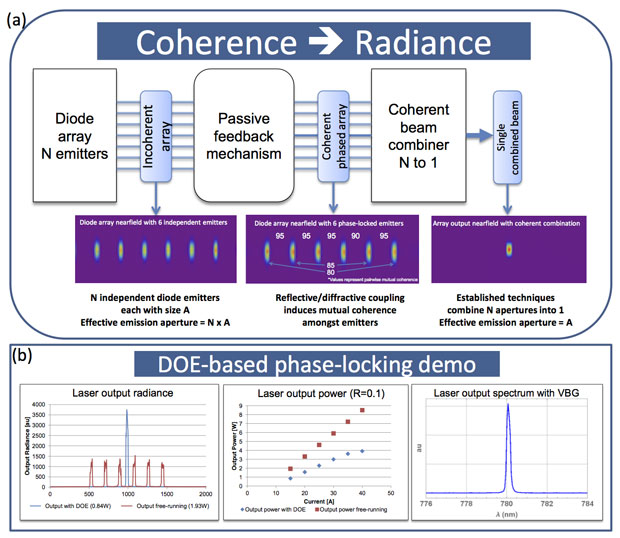Sheldon Wu (15-ERD-009)
Project Description
High-power, laser-diode-array technology for use as an excitation source for lasers has seen many advancements in the last 25 years, far beyond that of its predecessor, the flash lamp. These advancements, particularly the high efficiency and ruggedness of diode arrays, have enabled development in areas ranging from medical lasers to materials processing to directed energy. Optical coupling and phase locking, which induce coherence among otherwise independent laser-beam apertures, have long been recognized as techniques for increasing laser system radiance because they offer a tremendous simplification over existing laser systems. Recently, two technical issues impeding the development of these techniques have been resolved, and we are attempting to leverage these advances to increase both the spatial and spectral brightness of laser diode arrays. This project explores extending technologies in customized micro-optics arrays and spectral-selective partial reflectors in an optical scheme that establishes coherence between the individual facets in the array and, in so doing, enables higher beam-quality output than previously possible. We expect to demonstrate a phase-locked, multiple-kilowatt, direct-diode array in a robust and simple package that could readily be made available for use in directed-energy weapons and photon-assisted materials-processing applications. To accomplish this task, we will use a two-dimensional diode array comprised of bars with an anti-reflective coating on their output facets. This array also includes an optical conditioning package that consists of fast- and slow-axis collimating lenses and an advanced optic that corrects for errors across the individual bars. Then, using one of several well-developed, passive-cavity optical schemes to couple the individual apertures that make up the array, as well as using a spectrally selective mirror in the form of a continuous grating that covers the entire emission aperture of the array, we will close the laser resonator.
Mission Relevance
If successful, our research will greatly simplify diode-pumped systems, thus enabling the use of direct diodes in many applications. Simplifying laser systems for both directed-energy and material-processing applications supports a central Laboratory mission in national security and the core competency in lasers and optical science and technology. If successful, this project will generate intellectual property and licensing opportunities for the Laboratory.
FY16 Accomplishments and Results
In FY16 we investigated the brightness enhancement as well as the limitations of pairing customized micro-optics arrays with commercial diode array packages. Using an interferometric scheme, we measured mutual coherence among individual emitters on a diode array bar and examined two different phase-locking schemes (see figure). Specifically, we (1) utilized an intra-cavity spatial filter to measure mutual coherences greater than 80% between nearest neighbors with moderate optical loss; (2) created spatial filter designs with different materials and duty factors and recorded their phase-locking performance; (3) employed the Talbot effect, a near-field diffraction effect, to introduce feedback between emitters, and observed mutual coherences greater than 70%; and (4) investigated alternative schemes based on diffractive optical elements, which have recently become widely available commercially.
Publications and Presentations
- Wu, S., et al., External-cavity passively phase-locked laser diode arrays for radiance enhancement. Conf. on Lasers and Electro-Optics, San Jose, CA, June 5–10, 2016. LLNL-ABS-681340.
- Wu, S., et al., Radiance enhancement of diode laser arrays using advanced micro-optics and passive phase-locking techniques. Conf. on Lasers and Electro-Optics, San Jose, CA, June 5–10, 2016. LLNL-PRES-706160.






